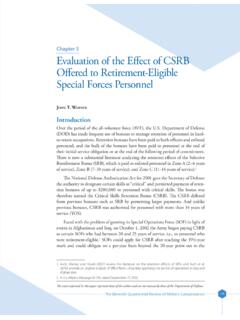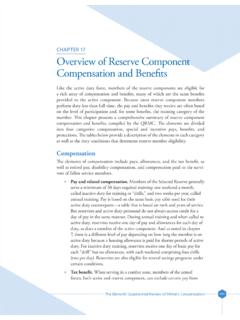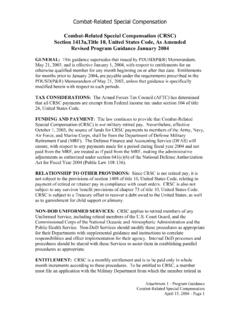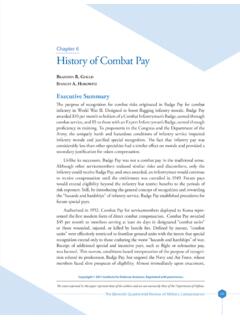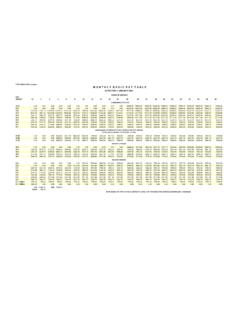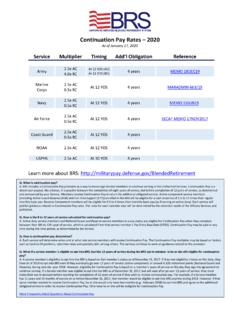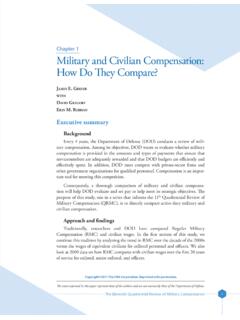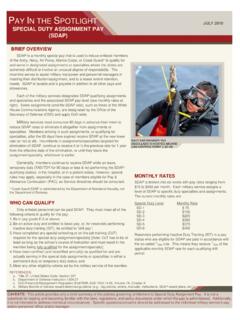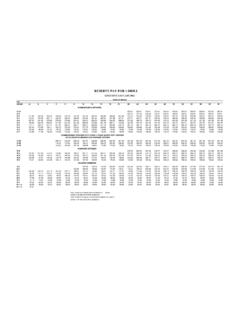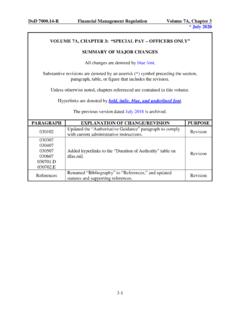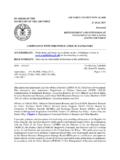Transcription of Chapter 4 Analysis of Staffing and Special and Incentive ...
1 107 The Eleventh Quadrennial Review of Military CompensationChapter 4 Analysis of Staffing and Special and Incentive Pays in Selected CommunitiesPaul f. hoGanKim DarlinGPatricK macKinJosePh munDymereDith swartzJohn t. warnerOverview of Method and ApproachThe review of compensation for selected critical career fields includes an Analysis of recruiting and retention experience across recent years; Analysis of civilian labor market alternatives for the community; documentation of incentives used to attract and retain personnel; and recommendations for changes in pay incentives to improve recruiting and approach to this Analysis includes the following steps:1.
2 Collect historical personnel data and historical, current, and future Staffing requirements2. collect current and historical information on recruiting and retention pay incentives3. review Staffing issues with service personnel4. evaluate civilian market supply and demand, and compensation5. obtain any empirical evidence demonstrating responsiveness of behavior to pay incentives and economic conditions6. analyze current Staffing and potential for improvements using the Officer and Enlisted Special and Incentive Pays Analysis Model developed for this purpose7. determine opportunities for improvement and model-projected force effects8.
3 Provide recommendationsThe views expressed in this paper represent those of the authors and are not necessarily those of the Department of Eleventh Quadrennial Review of Military Compensation108 Chapter 4We apply this general Analysis plan to each of four career fields we address. The following sections will describe any particular issues relating to each of those fields. Our approach is guided by the following considerations regarding the use of Special and Incentive (S&I) pays. Historically, S&I pays have been about 5 percent of total cash military compensation, yet they provide significant leverage to help the services manage the force.
4 They do this by targeting specific problems and issues without the constraint of paying all members the same amount regardless of Staffing conditions, or other factors that are relevant to only a subset of members or occupations. S&I pays tend to be high powered or efficient in that most of the compensation dollars go directly toward the identified Staffing or related problem. Criteria for application of S&I pays include the following: vExtraordinary civilian earnings opportunities. If the particular community faces extraordinary civilian earnings opportunities that would attract military members into the civilian sector, resulting in poor retention , S&I pays offer a way to increase military earnings for that community, making it more competitive.
5 Health professionals, such as physicians, are examples. vHigh training/replacement costs. It may be cost effective to improve the retention rates of communities for which training costs are especially high, and therefore replacing losses are particularly costly. Adding S&I pays in such occupations to improve retention may actually reduce the total costs associated with the community. Examples where this may be the case include pilots and nuclear trained officers. vRapid demand growth. When demand for an occupation increases, it may be efficient to increase retention , reducing losses, so that, along with increased accessions, Staffing and readiness goals can be achieved earlier, and perhaps at lower cost than relying solely on training new entrants.
6 It should be recognized that the additional retention incentives are likely to be temporary, and that once Staffing in the community has stabilized they may be reduced. vOnerous or dangerous conditions of service. Not all members face the same working conditions or the same dangers. Special and Incentive pays can be used to compensate members who face harsh or unpleasant working conditions or circumstances, or a greater risk of injury or death. The ability to attract and retain members under these circumstances remains a key criterion for assessing the case for S&I pays on this account. Examples of The Eleventh Quadrennial Review of Military Compensation109S&I Pays in Selected Communitiessuch conditions of service may include service in a combat zone, sea duty, or working with hazardous materials.
7 VSpecial skills and proficiency. Special and Incentive pays can be used to encourage the acquisition of a skill, or to provide an Incentive for improved proficiency in the skill. Use of the Foreign Language Proficiency bonus to encourage proficiency in select foreign languages is one example of the application of S&I pays for this purpose. vPerformance or productivity. S&I pays can be structured to provide incentives for increased performance or productivity. By rewarding performance or productivity, this application of S&I pays could motivate effort, increasing overall performance and productivity, and also provide a retention Incentive to those who have high performance.
8 In general, however, examples of this application of S&I pays are rare, perhaps because of the difficulties in measuring productivity in many military areas. These reasons for using S&I pays are not mutually exclusive. For example, occupations with high training costs may also have extraordinary civilian earnings opportunities. A key point, however, is that the use of S&I pays should, with few exceptions, result in an allocative effect or impact: because of the pay, individuals are induced to enter or remain in military service at higher rates, or to acquire skills and achieve proficiency at higher rates, etc.
9 The pays should induce changes in member behavior that result, ultimately, in improved Staffing , readiness, or proficiency. Prudent use of S&I pay resources means that the case for applying a pay should be evaluated carefully, based on its intended effect on retention and Staffing , readiness, or proficiency; the evidence that it will achieve the desired outcome; and the cost. Most importantly, existing applications of S&I pays should be periodically and systematically evaluated to insure that they are producing the force Staffing benefits intended, that these benefits are still needed, and that the S&I pay remains the cost-effective way to achieve the desired outcome.
10 In the Analysis of four selected communities below, we apply the basic principles and methods discussed in this section, and use the model described in Chapter 3 of this volume to evaluate overall Staffing in these communities and the application of S&I pays to these communities. In addition, Appendix 1 at the end of this Chapter contains tables that forecast the marginal costs of increased retention through the use of S&I pays for the communities examined below. (The occupational specialty codes for those communities are included in Appendix 2.)The Eleventh Quadrennial Review of Military Compensation110 Chapter 4 Special Operations ForcesIn the wake of September 11, 2001 and subsequent operations abroad in Afghanistan and Iraq, requirements for Special Operations Force (SOF) personnel have grown significantly.
